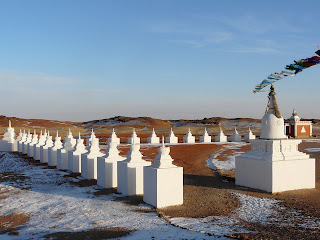Uuganaa is from Bayan Olgi in the west of Mongolia and has just started working with our Mongolian partner. She had worked as a tour guide during the previous summer and told me that before then she had thought she would like to marry a westerner, but having seen them as tourists she had chnaged her mind. The westerners were so helpless, like children, and could not do basic tasks. I can understand her change of mind, I am continually impressed by some of the Mongolians I work with who have made the transition from nomadic herder to multilingual entrepreneur.
Our trip to Sainshand was at the request of the governer, - to develop proposals for development of a tourism strategy and a land use plan. There were two main issues for the tourism strategy: the development of cross-border tourism with China, and the management of Khamaryn Khid monastery, one of the most famous and visited monasteries in the country.
After formal meetings we visited the monastery. At the time it seemed bizarre. The monastery is kilometres south of Sainshand, my first impression was, - Is this it? there were two restored temples,


a central stupa and an untidy collection of buildings and gers which were the homes of the monks.

After a quick visit to the monastery we were shown the other sites, an ovoo in the form of two breasts,

meditation caves, some petrified logs.

We then went to what was called the world energy centre where the Mongolians looked at a distant mountain, threw a glass of vodka into the air and said a prayer, three times. I left bemused, sure there were visitor management issues at the site, the control of cars, interpretation, the gobi landscape was magnificent but I was doubtful about its value as a tourist destination.


We returned to UB on the night train, arriving at 8 am. That night I met up with Tom and Konchog for a birding chat, Konchog told me that Altangerel who I had met had played an imprtant role in the preservation of monastery documents and texts during the communist period and the next day Konchog gave me a copy of a book The Lama of the Gobi about the life and times of Danzan raja, the nineteenth century Buddhist monk, poet, womanizer, drinker who had built this and many other monasteries. It was a great read and I realised how much I had missed, what a great story there is to be told about the site.


No comments:
Post a Comment